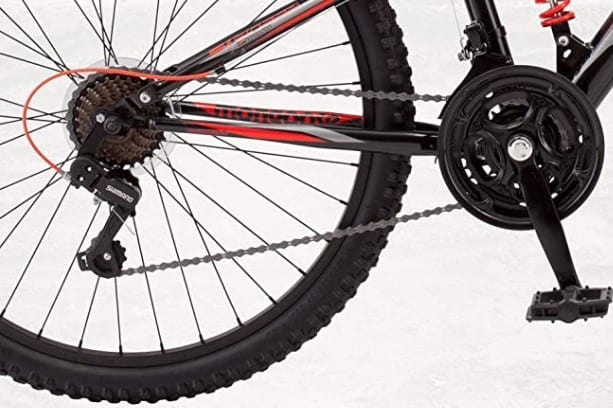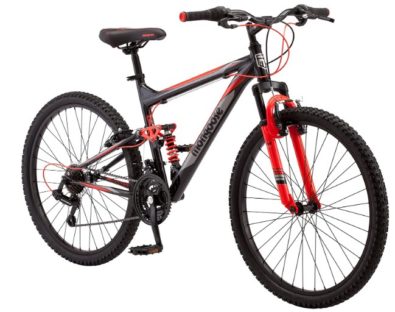Mountain biking is irrefutably great for power-building, agility, and muscle endurance. But the secret to having the right cadence (pedaling speed) is to know how to use gears on a mountain bike.
If not, here is an interesting summary of that.
How To Use Gears On A Mountain Bike
- Always start pedaling when you get on a mountain bike to build a rhythm
- Engage the left shifters to control the front gears
- Engage the right shifters to control the rear gear
- Shift to low gear when anticipating ascents or tailwind
- Shift to high gear when anticipating descents or headwind
I’ll explain the above pointers in detail and many other basics. Hopefully, I’ll help you understand your MTB’s gearing system much better and benefit from it.
But before that, let’s start with the basics. In particular, let’s start with the drivetrain and learn a few terms.

Understanding Bike Gears – The Drivetrain
The drivetrain refers to all moving parts which connect the crank system to the rear wheel. That includes the following components:
- Chain – This feature connects the front sprocket (chainring) to the rear cog.
- Chainring (sprocket) – This is the toothed ring on the drivetrain’s front end.
- Cassette – This is the stack of gears (cogs) on the drivetrain rear, featuring up to 11 gears.
- Derailleur – This is the mechanism that guides the chain and chainring when you shift the gears. It moves the chain between sprockets.
- Shifters – These are levers that control the derailleur through cabling
Remember, the gears are present to help you pedal smoothly on any terrain. So, it’s a matter of finding your most comfortable gears.
Terms To Remember On How To Use Gears On A Mountain Bike
- Cadence – This refers to the rate or speed of pedaling.
- Shifting – It refers to moving from one gear level to another.
- Downshifting – This is when you move to a low gear.
- Upshifting – This is when you move to high gear.
- Soft-Pedaling – This technique requires you to pedal harder on one stroke to build enough momentum for the next stroke. That’ll also ease the chain tension to enable the gears to move quickly.
How Do Bicycle Gears Work?
Generally, we’ve low gears (easy gears) and high gears (hard gears) on a mountain bike.
While low gears enable you to ride uphill, high gears allow you to descend and accelerate smoothly. Interestingly, you may not need any gear on flat ground, and if you’ve to, it’s hard to go past three.
In general, your job is to know how to shift between them to have a more natural experience.
Now that you know the answer to’ how do bike gears work?’ let’s describe these major gear types below:
Low Gear – The low gear (or the easy gear) is usually the smallest front chainring and the largest rear cassette cog. This gear combination is generally best for climbing.
High Gear – The high gear (or hardest gear) is usually the largest front chainring and the smallest rear cassette cog. It’s generally best for descending and accelerating.
In addition to the two gears, we also have the middle gear, your everyday cruising gear. So, whether you are riding on undulating or flat terrain, you get to shift smoothly with middle gear.

When To Shift Gears On A Bike
Remember, low gear is best for ascents. So, consider shifting to the low gear when you want to conquer a hill. But still, the low gear is suitable for riding against the headwind.
And when it comes to riding on flatter terrain, you have to use high gear. But given that the low gear is best for the headwind, the high gear is suitable for the tailwind.
The Basics On How To Use Gears On A Mountain Bike
Generally, an MTB has all the essential gears for making your off-road pedaling more manageable. Nonetheless, you have to master how to play with the bike gears to get the most from them.
Here are the basics for using MTB gears:
- Whenever you get on your mountain bike, start pedaling until you attain a comfortable rhythm before shifting the gears.
- On flatter ground, use the large chainring.
- Remember, the left shifter controls the bike’s front ring while the right shifter controls the front.
- For you to shift the chain to the middle sprocket, you’ve to engage the front shifters to move into the middle gear. That’ll help you climb and go against the headwind.
- Try maintaining the front gear in the final gear range and continue shifting up and down to improve the resistance.
- Shift the rear cassette into the middle gear to switch to high gear.
- Once you are near the mountain, switch to a low gear.
Remember, it takes practice, especially on varying terrains, to master how to use a mountain bike with gear and get the most out of it (the bike gear). With time, you’ll get to shift more naturally.
A Quick Summary On How To Shift Gears On A Bike For Dummies
Remember, the shifters are the levers necessary for applying brakes. To operate them on a mountain bike, you need to use your thumb.
Shifters are generally connected to cable housing. So, whenever you engage the gears, the cable either tightens or loosens, affecting the derailleur’s movement.
Below is a summary of what each shifter/lever does.
- Left shifter – Moves the chain up and down the bike’s chainring to control the bike’s front gears/derailleur.
- Right shifter – Moves the chain up and down the cassette to control the rear gears/derailleur.
Now, below are vital takeaways when learning to shift bicycle gears for dummies:
- Use the left shifters to shift between the chainrings.
- Use the right shifters to shift the rear gears.
- Shift to high gear to build enough resistance whenever you want to slow down.
- Shift to a low gear to improve your cadence if you are riding too slowly.
- Remember, moving the bike’s chain away improves your speed, while moving it closer slows you down.
- While the left shifters control the front gears, the right shifters control the rear gears.
- Don’t forget the soft-pedaling technique when you fail to anticipate the correct gear.
- Target to maintain consistent cadence as you maximize power output. That’ll ensure you continue riding even when you run out of steam.

Relevant:
FAQs On How To Use Gears On A Mountain Bike
1. What Bike Gear To Use On Flat Road?
A flatter road requires you to use the high gear, also known as the hardest gear. The bicycle gear is best for accelerating, something you want when riding on a uniform ground.
In a high gear position, pedaling is challenging as you require more energy to do it.
2. What Gear Should I Use Going Uphill?
While the high gear is best for accelerating flatter roads, the low gear (also known as the easy gear) is best for going uphill.
In a low gear position, pedaling is much more comfortable as you require the least amount of energy to do it.
3. How Should I Use The Gears On My Bike?
You must anticipate the gearing you’ll need for a particular terrain. In that case, you should shift naturally to a high gear when you expect descending, accelerating, or riding on tailwind.
In contrast, you should shift on a low gear when you anticipate riding uphill or against the headwind.
4. What Gear Do I Need For Mountain Biking?
You need both high gear and a low gear when mountain biking. It all depends on your cycling terrain.
If you want to climb or ride against the headwind, you need low gear. But if you’re going to descend or accelerate on flat ground or ride on tailwind, consider shifting to high gear.
And if you want to ride naturally, the middle gear will do. What’s important is to know how to shift between the various gears naturally.
5. How Do You Change Gears On A Mountain Bike Smoothly?
The secret is to anticipate your change in terrain to have a smooth transition of the bike gears. For example, learn to move to high gear when you expect accelerating or descending or even riding on tailwind.
On the other hand, you should shift to a low gear when you anticipate a hill or a headwind.
6. How Do You Use High And Low Gears On A Bike?
It depends on the terrain and wind conditions. You use a high gear when you expect acceleration, especially on flat ground or down the slope.
But still, high gear comes in handy when riding on tailwind.
In contrast, low gear is best when you expect to conquer a climb and cycle against the tailwind.
Closing Thoughts:
Now you know how to use gears on a mountain bike. I’ve shared the basics. So, it’s up to you to employ the tips in your everyday mountain biking.
In no time, you’ll be able to shift the gears more naturally like a pro.
Frequently Asked Questions
What mountain bike gears to use when?
Mountain bike gears are varied, and different gears are used under different circumstances. For example, if you’re maneuvering up a steep incline or mountainous terrain, the best choice would be to shift your chain to the larger cogs, situated at the back of the bike. This progression allows for easier pedaling, making the uphill battle far less taxing. Likewise, if you’re cruising down a descent or generally keeping a fast pace, switch your gears so that the chain rests on the smaller cogs, also at the back. This will make the pedaling more resistant, thereby challenging your leg muscles and enabling speedy cycling. So, shift to larger cogs for easier pedaling (like climbing), and smaller cogs for a tougher ride (like descending).
Is gear 1 high or low on a bike?
Often, beginners are unsure whether gear ‘1’ on a bike represents a high or low gear. To clarify, gear ‘1’ is typically a low gear, similar to how gears function in a vehicle due to similar principles. This low gear is your ally when it comes to challenging terrains or uphill climbs. When your ride becomes difficult, or when you’re cycling at a slower pace, drop down to gear ‘1’. You’ll notice it makes pedaling much easier and less strenuous. In other words, gear ‘1’ is often considered the ‘easy’ gear, even though its usage often correlates with rough riding. So, gear ‘1’ in the context of a bike is a low gear, best for difficult terrains or slow, steady rides.
How do you shift gears on a mountain bike for beginners?
Shifting gears on a mountain bike may seem intimidating at first, but with a little practice, it becomes second nature. For beginners, it’s crucial to remember that the gears are there to assist you, not hinder your journey. The large and small cogs at the back of the bike will need to be adjusted depending on whether you need more or less resistance. For easy pedaling, shift to the larger cogs, and for more resistance, shift to the smaller ones. Practice this on a flat surface first until you get comfortable. Like every skill, gear shifting also takes time and practice to master. Bear in mind, shifting to larger cogs results in easier pedaling, while shifting to smaller ones causes more resistance.